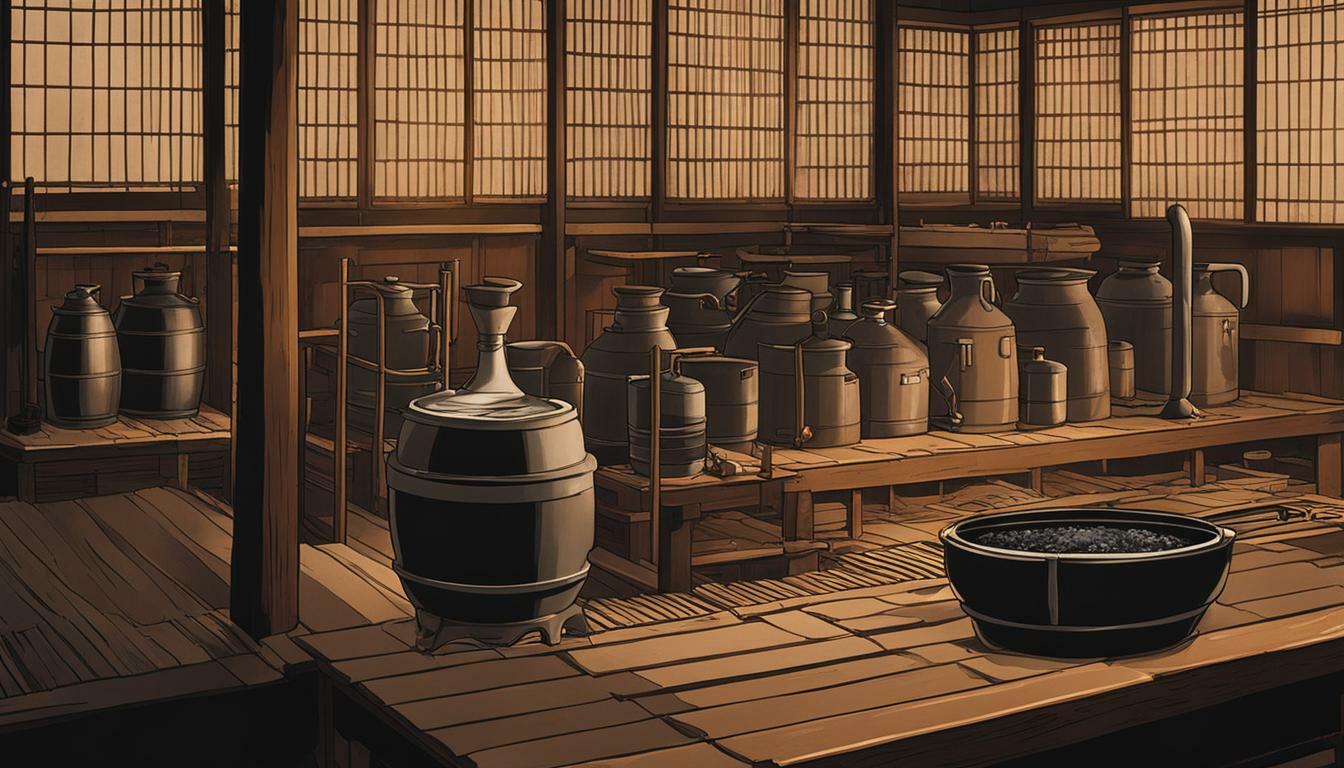Discover How Shochu is Made: Japan’s Unique Spirit
Shochu is a beloved Japanese spirit that is made through a fascinating process of distillation and fermentation. It is a unique spirit that is largely unknown in the global market, but its potential is immense. Made using koji, a Japanese culture of fermentation, shochu combines traditional brewing and distilling techniques to create a one-of-a-kind beverage.
During the shochu making process, various ingredients such as rice, barley, sweet potatoes, and brown sugar can be used. Each ingredient brings its own distinct qualities and flavors to the final product. Shochu undergoes a maturation process, where it is aged in stainless steel, clay, or wood barrels. The duration of aging can vary from a few months to several years, resulting in a wide range of flavors and aromas.
One of the unique aspects of shochu is its lower alcohol content compared to other spirits. This makes it a versatile drink that can be enjoyed straight or as a base for cocktails. Whether sipped neat or mixed in a creative concoction, shochu offers a delightful drinking experience.
It is important to retain oils during filtration to enhance the weight and character of the shochu. This contributes to the overall flavor profile of the spirit, making it more complex and nuanced. The aging process of shochu adds value to the spirit, similar to how whisky gains complexity over time.
Key Takeaways:
- Shochu is a unique Japanese spirit made through distillation and fermentation.
- Koji, a Japanese culture of fermentation, is used in the production of shochu.
- Shochu can be made from various ingredients, resulting in different flavors.
- The maturation process of shochu takes place in stainless steel, clay, or wood barrels.
- Shochu has a lower alcohol content compared to other spirits and can be enjoyed straight or mixed in cocktails.
The Shochu Making Process
The art of making shochu involves a meticulous process that combines the use of koji, fermentation, and distillation techniques. Koji, a traditional Japanese fermentation starter, plays a crucial role in converting the starches in the base ingredients into fermentable sugars, which are then transformed into alcohol during the fermentation process.
First, the base ingredients, such as rice, barley, sweet potatoes, or brown sugar, are steamed and cooled. Then, koji is mixed with the cooked grains to initiate the fermentation process. The mixture is kept in a warm environment for several days, allowing the koji enzymes to convert the starches into sugars.
After fermentation, the resulting liquid, known as moromi, is distilled to separate the alcohol from the solids. The moromi is transferred to a pot still, where it is heated to evaporate the alcohol. The vapor is then condensed and collected, resulting in a clear and flavorful shochu.
Throughout the shochu making process, careful attention is given to the quality of the ingredients and the precision of each step. From the selection of the base ingredients to the temperature control during fermentation and distillation, every detail contributes to the unique character and taste profile of the final product.
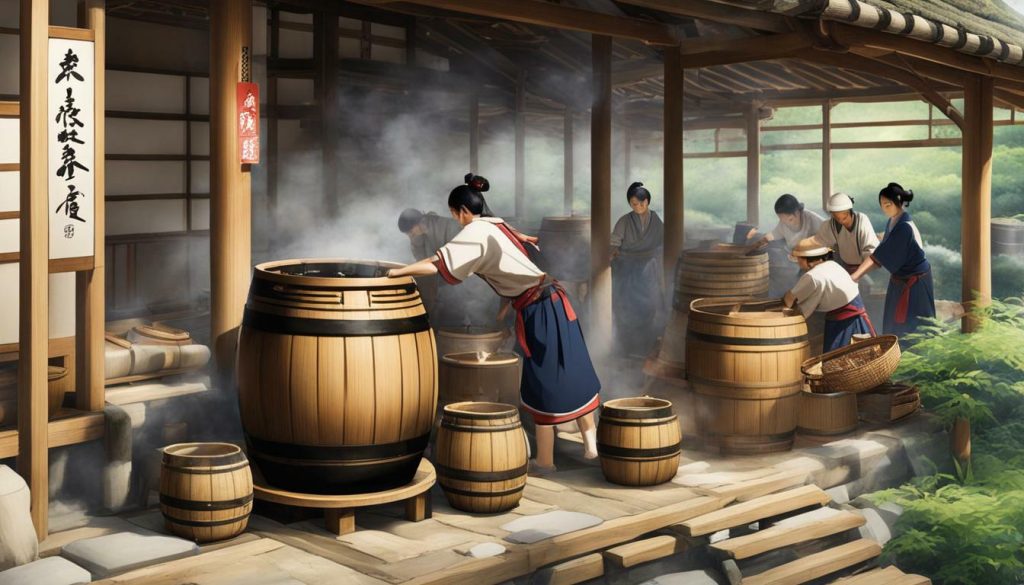
| Step | Process |
|---|---|
| 1 | Preparation of base ingredients |
| 2 | Mixing koji with cooked grains |
| 3 | Fermentation of the mixture |
| 4 | Distillation of the moromi |
| 5 | Collection of the distilled alcohol |
Ingredients Used in Shochu Production
Shochu can be made from a variety of ingredients, including rice, barley, sweet potatoes, and brown sugar, each imparting its unique characteristics to the spirit. The choice of ingredients used in the production of shochu greatly influences the flavor profile and overall quality of the final product.
Rice: Rice-based shochu, known as “kome-jochu,” is one of the most common types of shochu. It is made from fermented rice and typically has a smooth and clean taste. The use of high-quality rice leads to a more refined and delicate flavor.
Barley: Barley-based shochu, or “mugi-jochu,” is another popular variety. It imparts a nutty and slightly sweet flavor to the spirit. The brewing process for barley shochu involves steaming the barley and fermenting it with koji before distillation.
| Ingredient | Flavor Profile |
|---|---|
| Rice | Smooth and clean |
| Barley | Nutty and slightly sweet |
| Sweet Potatoes | Rich and earthy |
| Brown Sugar | Caramel-like sweetness |
Sweet Potatoes: Sweet potato shochu, or “imo-jochu,” is a regional specialty of Kyushu in Japan. It has a rich and earthy flavor with a hint of sweetness. The sweet potatoes are steamed, mashed, and fermented with koji to create a unique and flavorful shochu.
Brown Sugar: Brown sugar shochu, or “kokuto-jochu,” is made from Okinawan brown sugar. It is known for its caramel-like sweetness and deep flavor. The unique characteristics of brown sugar shochu make it a favorite choice for those who enjoy a rich and robust spirit.
Exploring Flavor Profiles
- Rice-based shochu: Smooth and clean
- Barley-based shochu: Nutty and slightly sweet
- Sweet potato-based shochu: Rich and earthy
- Brown sugar-based shochu: Caramel-like sweetness
Each ingredient used in shochu production brings its own distinct flavors and aromas to the spirit, offering a wide range of options for shochu enthusiasts to explore and enjoy.
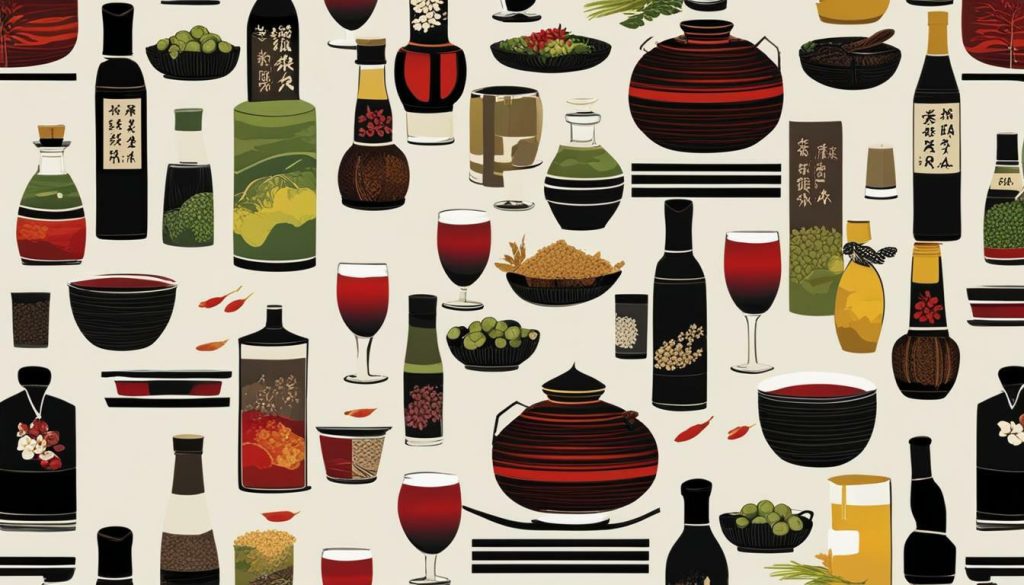
As you can see, the choice of ingredient plays a crucial role in shaping the unique flavor profiles of shochu. Whether you prefer the smoothness of rice, the nuttiness of barley, the richness of sweet potatoes, or the sweetness of brown sugar, there is a shochu variety to suit every palate. So, the next time you raise your glass of shochu, take a moment to appreciate the craftsmanship and the natural ingredients that go into creating this distinctive Japanese spirit.
The Maturation Process of Shochu
After the initial production, shochu undergoes a maturation process, where it is carefully aged in various types of barrels to develop its distinct flavors and aromas. The choice of barrel plays a significant role in the final product, as each type imparts its own characteristics onto the shochu.
The most common types of barrels used for maturing shochu are stainless steel, clay, and wood. Stainless steel barrels are favored for their neutral flavor profile, allowing the shochu to maintain its original essence. Clay barrels, on the other hand, add earthy and mineral notes to the spirit, creating a unique taste experience. Wood barrels, such as oak or chestnut, provide depth and complexity to the shochu, infusing it with flavors and aromas from the wood.
During the maturation process, the shochu undergoes a transformative journey as it interacts with the barrel’s material. The length of aging can vary, typically ranging from a few months to several years. As the shochu matures, it absorbs the flavors and aromas from the barrel, resulting in a more refined and complex spirit.
| Barrel Type | Characteristics |
|---|---|
| Stainless Steel | Neutral flavor profile, preserves original essence |
| Clay | Earthy and mineral notes, unique taste experience |
| Wood (Oak or Chestnut) | Depth and complexity, flavors and aromas from the wood |
Enjoying Shochu: Straight or in Cocktails
Shochu can be savored either straight, allowing its unique flavors to shine, or as a key ingredient in a variety of delicious cocktails. Its lower alcohol content makes it a versatile spirit that can be enjoyed on its own or mixed into refreshing concoctions. Whether you prefer a classic highball or a creative twist on a cocktail, shochu offers a world of possibilities.
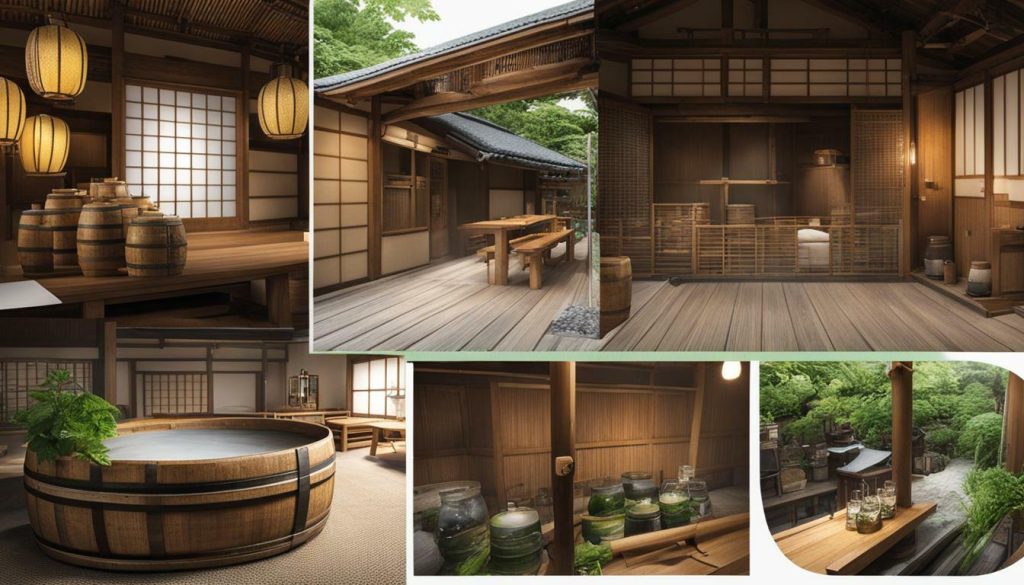
One popular way to enjoy shochu is by mixing it with soda water for a refreshing highball. The bubbles from the soda water bring out the subtle nuances of the spirit, while still allowing its natural flavors to take center stage. It’s a simple and elegant way to appreciate the craftsmanship that goes into making shochu.
If you’re feeling more adventurous, shochu can be a great addition to a variety of cocktails. Its versatility as a base spirit allows it to blend seamlessly with other ingredients, creating unique flavor profiles. From fruity concoctions to herbal infusions, shochu can elevate any cocktail recipe.
Try this refreshing shochu cocktail recipe:
- Ingredients:
- 2 ounces shochu
- 1 ounce fresh lemon juice
- 1/2 ounce simple syrup
- Club soda, to top
- Lemon twist, for garnish
- Instructions:
- In a cocktail shaker, combine shochu, lemon juice, and simple syrup.
- Add ice and shake until well chilled.
- Strain into a glass filled with ice.
- Top with club soda.
- Garnish with a lemon twist.
Whether you prefer it straight or mixed into a cocktail, shochu offers a unique and enjoyable drinking experience. Its versatility and distinctive flavors make it a standout choice for those looking to explore the world of Japanese spirits. So go ahead, raise a glass of shochu and toast to the rich traditions and craftsmanship behind this remarkable spirit.
The Value of Aging Shochu
Aging shochu is a highly regarded practice that adds depth and complexity to the spirit, making it akin to whisky in terms of its flavor profile. Just like whisky, the maturation process of shochu takes place in stainless steel, clay, or wood barrels, allowing the spirit to develop unique flavors and aromas over time.
During the aging process, shochu undergoes a transformation as it interacts with the barrel, absorbing the characteristics of the wood or clay. This interaction imparts additional layers of complexity to the spirit, resulting in a more refined and nuanced flavor profile. The choice of barrel material can influence the final product, with stainless steel providing a clean and crisp taste, clay offering a mineral-rich profile, and wood barrels imparting a delicate woody note.
As shochu ages, it undergoes chemical changes that enhance its appeal to discerning palates. The process allows for the slow release of flavors from the ingredients used in its production, resulting in a harmonious blend of flavors. The aging period can vary from a few months to several years, with each duration offering a distinct taste experience.
| Benefits of Aging Shochu | Effects on Flavor Profile |
|---|---|
| Enhanced complexity | A richer and more layered taste |
| Smoothness | A velvety texture with mellowed edges |
| Refined aroma | A captivating scent with hints of wood or clay |
| Balanced flavors | A harmonious blend of ingredients |
For those looking to explore the world of aged spirits beyond whisky, shochu offers a captivating alternative. Its delicate flavors and unique production process make it a worthy addition to any spirits collection. So next time you’re in the mood for a drink with character, consider reaching for a bottle of aged shochu and savor the distinctive flavors it has to offer.
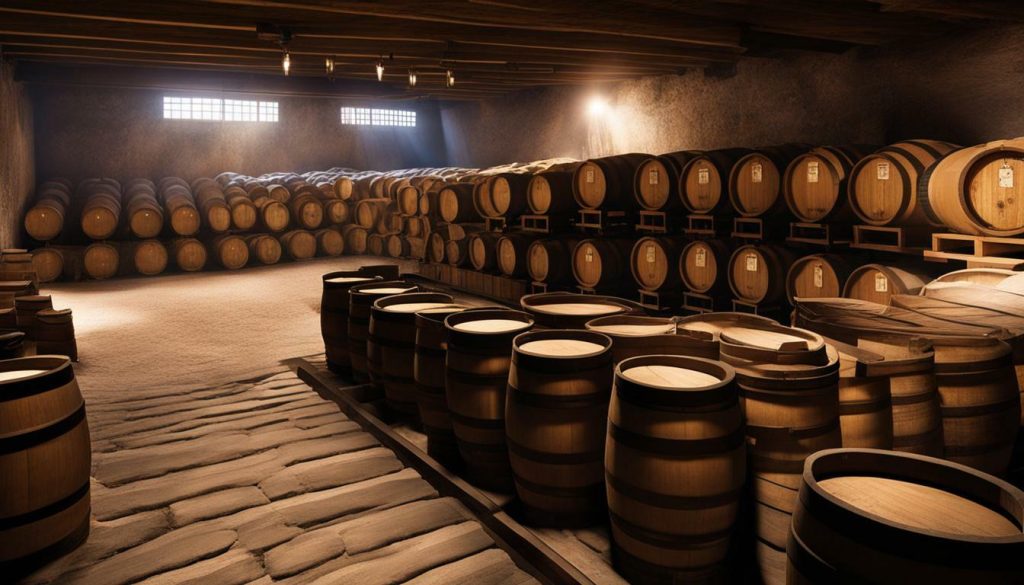
Through the artful combination of distillation, fermentation, and aging techniques, shochu emerges as a distinctive spirit that embodies the rich tradition of Japanese craftsmanship. This unique Japanese spirit, largely unknown in the global market, holds immense potential. Shochu is made using koji, a Japanese culture of fermentation, along with brewing and distilling methods.
Made from a variety of ingredients including rice, barley, sweet potatoes, and brown sugar, shochu undergoes a maturation process in stainless steel, clay, or wood barrels. The aging period can vary from a few months to several years, resulting in a wide range of flavors and aromas.
With a lower alcohol content compared to other spirits, shochu can be enjoyed both straight or mixed in cocktails, offering versatility in drink recipes. Retaining oils during filtration is essential to enhance the weight and character of the shochu.
Aging shochu adds value to the spirit, offering complexity and flavors similar to whisky. This unique characteristic makes shochu a captivating option for those seeking a distinctive taste experience. As shochu gains recognition in the global market, more and more people are discovering the secrets behind this delightful Japanese tradition.
FAQ
How is shochu made?
Shochu is made through distillation using koji, a Japanese culture of fermentation. It involves both brewing and distilling techniques.
What ingredients are used in shochu production?
Shochu can be made from various ingredients such as rice, barley, sweet potatoes, and brown sugar. Each ingredient contributes to the flavor profile of the final product.
How is shochu aged?
Shochu is aged in stainless steel, clay, or wood barrels. The aging process can range from a few months to several years, resulting in different flavors and aromas.
Can shochu be enjoyed straight or mixed in cocktails?
Yes, shochu can be enjoyed both straight or mixed in cocktails. It has a lower alcohol content compared to other spirits and is versatile in various drink recipes.
How does aging affect the flavor of shochu?
Aging shochu enhances its flavor and complexity. It is important to retain oils during filtration to enhance the weight and character of the shochu.
